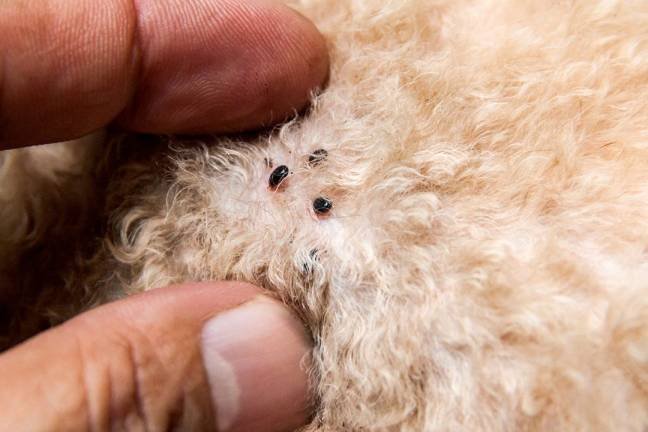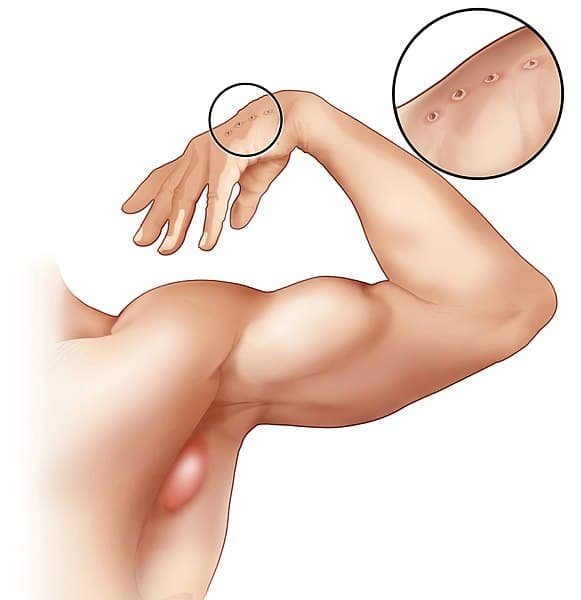Having a cat infested by fleas is already a big problem for any cat owner because flea bites irritate and itch. Unfortunately, the problem can get aggravated because fleas are disease carriers. In fact, they can cause flea-borne diseases in humans as well as cats.
Flea-borne (murine) typhus, cat-scratch disease, and the plague (yes, that one) are some of the diseases cats can carry and pass to humans in the US. But cat fleas can also cause diseases in cats themselves, including flea allergy dermatitis, Bartonellosis, flea-associated anemia, and tapeworms.
How do Fleas Cause Disease in Cats and Humans?
Like other types of fleas, cat fleas prefer to live on animal hosts. However, cat fleas spread to humans when human hosts are readily available. This is especially true in an environment with many cat fleas or where animal hosts are unavailable.
But how long can cat fleas live on humans?
Cat fleas will usually not live on humans. They will simply bite and soon disappear. The reason why they bite humans is to get their blood meal. Afterwards, they transfer to an animal host as soon as they spot one.

Adult cat fleas find their hosts through the targeted animal or human’s body heat, breathing, and movement.
According to a study, 80% of fleas in cats are carriers of at least one disease-causing organism. Fleas cause disease and sickness in cats and humans in two main ways:
- The flea bites cause an infection on the cat or human skin.
- The flea is a carrier of a disease and transmits it to the cat or human through the bite wound or when ingested.
Flea-associated Illnesses in Cats
So, fleas can cause disease and illness in cats through their bite or transmit disease-causing viruses and bacteria to cats.
There are two major illnesses caused by flea bites on cats:
- Flea allergy dermatitis
- Flea-associated anemia.
Flea Allergy Dermatitis
Flea allergy dermatitis is a skin condition caused by flea saliva on the cat’s skin. When fleas bite, they deposit saliva into the bite wound to help them suck their host’s blood. To the fleas’ benefit, their saliva has an anticoagulant that prevents blood clotting so they can suck the blood successfully.
To the cat, the flea saliva causes itching and irritation, which can escalate to flea saliva allergy.
If your cat is hypersensitive to flea bites, it will only take a few bites to manifest flea allergy symptoms.
The symptoms of flea allergy dermatitis include:
- Skin irritation and itching.
- Skin inflammation.
- Excessive scratching and grooming can lead to hair loss, especially on the tail, belly, rump, and inner thighs.
- Red oozing sores.
- Flea bite scabs.
- Secondary bacterial and fungal skin infections.
Eliminating fleas on your cat is the ultimate solution for flea allergy dermatitis. However, antibiotic and antifungal medications can be prescribed to cure secondary skin infections caused by flea bites. Short-term treatment with corticosteroids may also be prescribed to control itching and inflammation.
Any treatment for secondary flea-associated skin infections on your cat should always be prescribed by a veterinarian after proper diagnosis.
Flea-associated Anemia
Fleas suck blood from your cat. If your cat has a large number of fleas, it can have significant blood loss, leading to anemia. Kittens are especially at risk of flea-associated anemia.
Cats with anemia from flea infestation will show the following signs:
- General weakness due to poor oxygen supply to vital organs.
- Lethargy.
- Difficult breathing.
- Organ failure (in severe cases), which can turn fatal.
If a cat has severe flea infestation and has signs of anemia, immediate vet care should be given. In this case, treatment will consist of a blood transfusion to revert the anemia. The required cat flea treatment will follow to remove cat fleas completely.
Diseases Transmitted by Fleas

As carriers of disease, cat fleas can transmit two kinds of diseases to cats:
- Bartonellosis.
- Cat flea tapeworms.
Bartonellosis
Bartonellosis (Feline Bartonellosis) is a bacterial infection caused by the Bartonella henselae bacteria. Cats contract this infection by ingesting infected fleas or flea droppings when grooming.
Cats are usually asymptomatic for bartonellosis. However, there are several medical conditions associated with bartonellosis infection in cats. These include:
- Eye inflammation.
- Heart disease.
- Mouth and gum disease.
In addition, infected cats will become carriers of the Bartonella bacteria and can pass it to humans if they scratch or bite.
Cats can carry Bartonella bacteria for a long period. Any fleas that bite an infected cat can become carriers as well. According to the CDC, Bartonella Henselae bacteria is documented in 30%-40% of domestic and shelter cats in the US.
Rare clinical signs of feline bartonellosis can manifest when a cat is under stress or has other diseases. The clinical symptoms include:
- Fever.
- Vomiting.
- Lethargy.
- Swollen lymph nodes.
- Loss of appetite.
- Red eyes.
Diagnosing Bartonellosis
A blood test or blood tissues of the lymph nodes of a cat is used to diagnose cats for bartonellosis. A polymerase chain reaction test (PCR test) can also be used to amplify Bartonella DNA sequences.
Cats confirmed to be infected with bartonellosis are treated with antibiotics such as Doxycycline, Enrofloxacin Amoxicillin, and Rifampin. The treatment goes on for 30 to 45 days.
However, treatment with these antibiotics is only confirmed to reduce the level of the bacteria. Their ability to completely clear the Bartonella bacteria in cats is not yet established.
Cat Fleas Tapeworms
Fleas are a core part of the tapeworm lifecycle. They act as the intermediate hosts for tapeworms, and they cannot complete their life cycle without fleas.
When a cat has fleas, it can get tapeworms by ingesting fleas or flea larvae. Once in the cat’s stomach, the larva develops into adult tapeworms, which then attach to the cat’s intestines.
Cats with tapeworms may not show any symptoms in the beginning. With time, however, cats may show tapeworm symptoms such as:
- Abdominal pain.
- Diarrhea.
- Weight loss.
- Itching around the anus.
- Proglottids in the cat’s stool or around the anus.
If your cat has fleas, ensure you faithfully give your pet deworming medication to get rid of any cat fleas tapeworms.
Diseases Humans can get from Cat Fleas

As in cats, fleas can cause diseases in humans, both from biting or as carriers of bacteria and viruses. There are 3 common cat flea zoonotic diseases (spreads from animals to humans) in humans:
- Plague.
- Cat scratch disease (Bartonella henselae infection).
- Flea-borne murine typhus.
Plague
Flea-associated plague is a serious disease caused by the Yersinia pestis bacteria and transmitted from cats by fleas to humans. The origin of plague is thought to be in Central Asia. The bacteria is blamed for the infamous “Black Death” that killed millions in Europe during the 14th and 17th centuries.
Humans get plague when an infected flea bites them. However, direct contact with infected flea dirt or inhalation of the same can also cause infection.
The severity of the plague in humans depends on the form of infection.
There are 3 different forms of plague in humans
- Bubonic plague is contracted through a flea bite and is the most common. The bacteria enters the body through a flea bite and goes to the nearest lymph node. The lymph node becomes inflamed, and the infected person can experience pressure and pain from the spot. With time, the inflamed nodes can turn into oozing sores.
- Septicaemic plague describes plague infection that has spread to the bloodstream. This can happen from flea bites or exposure to infectious material that enters the body through skin sores. Septicaemic plague can also be an advanced stage of the bubonic form.
- Pneumonic plague (lung-based plague) is a severe form of plague but the least common. It results from advanced bubonic plague and is often fatal. Unlike the other two variants, people with pneumonic plague can transmit it to other humans through infected aerosolized droplets.
If left untreated, the septicaemic and pneumonic forms of plague have a fatality rate of 30% to 100%.
The incubation period of the Plague is 3 to 7 days. People with plague will show influenza-like symptoms, including fever, body aches, chills, nausea, vomiting, and general body weakness.
Plague is diagnosed through laboratory testing of pus, blood, or sputum samples for the Yersinia pestis bacteria.
The treatment of plague consists primarily of antibiotics paired with effective supportive therapy.
Cat Scratch Disease (Bartonella henselae Infection)
Cat scratch disease (also cat scratch fever) is caused by the bartonella henselae bacteria. The bacteria are passed from fleas to cats and from cats to humans through bites, scratches, or licks on open wounds.
After 3-14 days, the infected skin will show signs of infection like swelling, redness, and eventually pus.
Other clinical signs associated with cat scratch diseases include fever, loss of appetite, fatigue, and headache. The lymph nodes around the area of infection may also become swollen and cause pain.
The diagnosis and treatment of cat scratch disease depend on the patient’s condition. According to CDC, cat scratch disease is not tested or treated in healthy people but only in cases of severe illness. Consult a medic if you experience severe symptoms that point to possible cat scratch fever.
In rare cases, cat scratch disease can cause serious complications affecting the eyes, heart, brain, and other vital organs. This is especially true in children of 5-14 years and persons with compromised immunity.
Washing cat scratches and bites thoroughly with soap and running water will help prevent infection. Also, keep cats from licking your wounds, and wash your hands any time you interact with your pet.
Flea-borne Murine Typhus
Flea-borne murine typhus is a bacterial disease caused by the Rickettsia typhi bacteria. People contract murine typhus through flea bites or contact with infected flea dirt.
Infection through flea dirt happens when the dirt is rubbed on flea bite wounds or other previously existing wounds on the person’s skin. Additionally, inhaling infected flea dirt or rubbing it into your eyes can also cause infection. The disease is not transmitted from human to human.
Murine typhus is especially common in subtropical and tropical climates. Such areas in the US include Hawaii, Texas, and Southern California. Nonetheless, flea-borne murine typhus is rarely reported in the United States.
The clinical symptoms of flea-borne murine typhus will show within 14 days after infection.
The symptoms include:
- Fever and chills.
- Nausea and vomiting.
- Muscle pain and general body ache.
- Loss of appetite.
- Stomachache.
- Body rash.
- Coughing.
Cases of severe murine typhus are extremely rare, and most infected people will recover completely without any treatment. When severe illness does happen, flea-borne murine typhus can cause damage to vital organs, including the heart, liver, lungs, kidneys, and brain.
Since the symptoms of murine typhus are a lot similar to those of other diseases, you should report contact with fleas to your health provider if you go with the above symptoms.
Diagnosis for murine typhus is done through blood testing for Rickettsia typhi and can take weeks to be reported. Your doctor may put you on treatment if s/he suspects murine typhus even before the test results are out.
Treatment for flea-borne murine typhus consists of a doxycycline dosage, which is effective in the majority of cases.
Other uncommon cat fleas zoonotic diseases that can be found in humans include tapeworms, flea-borne spotted fever, and Mycoplasma haemofelis (formerly Hemobartonella felis).
As with all other diseases, flea-borne cat diseases and cat flea-borne zoonotic diseases are best prevented.
How to Prevent Flea-borne Diseases in Cats and Humans

It is evident that the best way to prevent flea-borne illnesses in cats and humans is to keep fleas at bay. This should be done by treating your cat for fleas immediately after you notice their presence on the pet.
Preventative flea treatments are also advised but should only be used after consultation with your cat’s vet.
Further, you should vacuum your home frequently to control cat fleas. If you have a flea infestation in your home, consider hiring the services of a pest control agent.
Other preventative measures include:
- Thoroughly clean your hands with running water and soap every time you touch your cat.
- Washing cat scratches or bites with soap and running water as soon as they happen.
- Opting for older cats if you have compromised immunity, as kittens are more prone to flea-borne diseases.
- Not touching or petting stray or feral cats.
- Keeping your cat indoors as much as possible and preventing any occasions where your cat will fight with stray or feral cats.
- For health workers, avoid direct contact with a material that could be infected with flea-borne diseases such as plague.
- For government agencies, alerting people when zoonotic plague and other flea-borne diseases are reported in your area and giving them advice on how to take precautions and keep themselves safe.
Cat Flea Borne Diseases in Humans FAQs
Cat fleas can jump on humans, but they don’t live on humans.
Yes! Once on a human, fleas will bite to take their blood meal and jump back to an animal host as soon as one is available.
Since cat fleas prefer animal hosts, they may not find it easy to jump on a human body unless the person is seated next to their pet or lying next to it. As such, the most accessible human parts that cat fleas bite are the feet, legs, and ankles. But fleas can walk and jump on your clothing and bite other parts of the body and even get into your hair.
Have you ever wondered “Are cat fleas harmful to humans?” Well, yes! Cat fleas can cause diseases such as cat scratch fever, flea-borne murine typhus, and even plague in humans. In rare cases, cat fleas tapeworms have also been reported in humans, especially children.
Under normal circumstances, cat fleas will not live on your body for a substantial amount of time. That’s because cat fleas thrive best on an animal host with fur or feathers, and humans lack both. Being in animal fur allows fleas to hide better, and they can also lay their eggs and reinitiate their life cycle. Besides, humans will likely shake or wash off a flea before it can breed.
Featured Image Credit: Katja ZSM, CC BY-SA 3.0, via Wikimedia Commons
